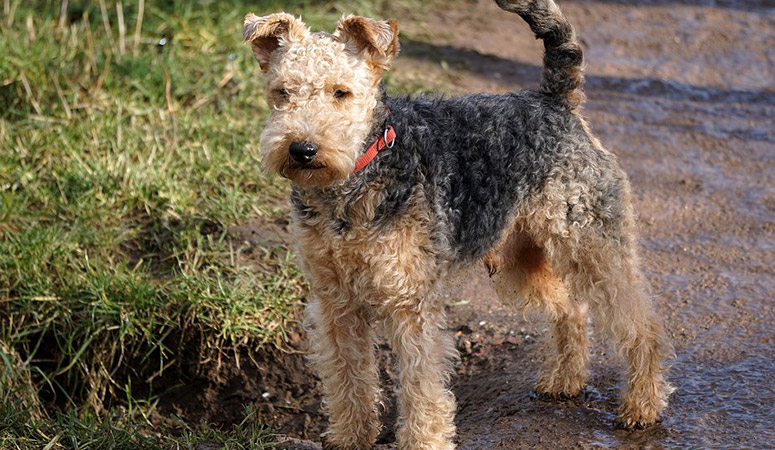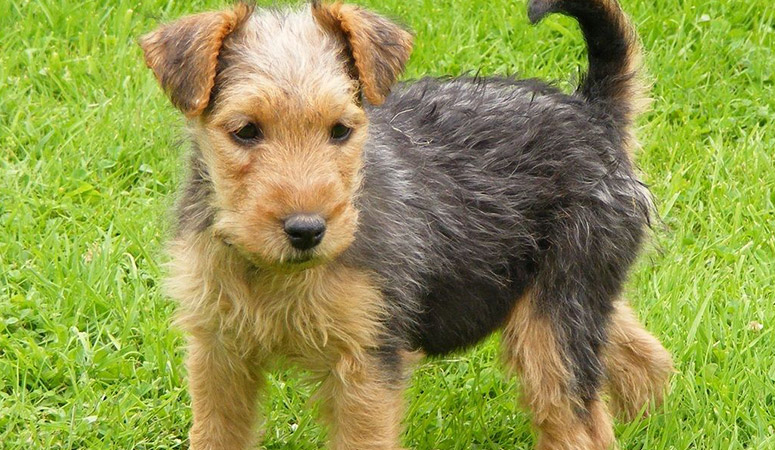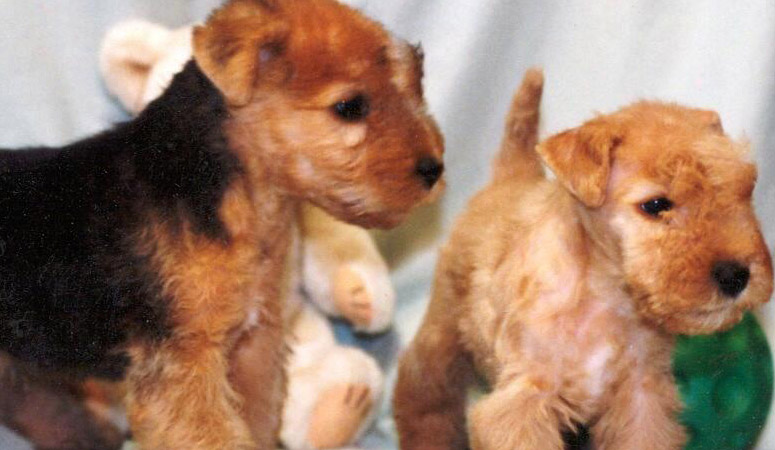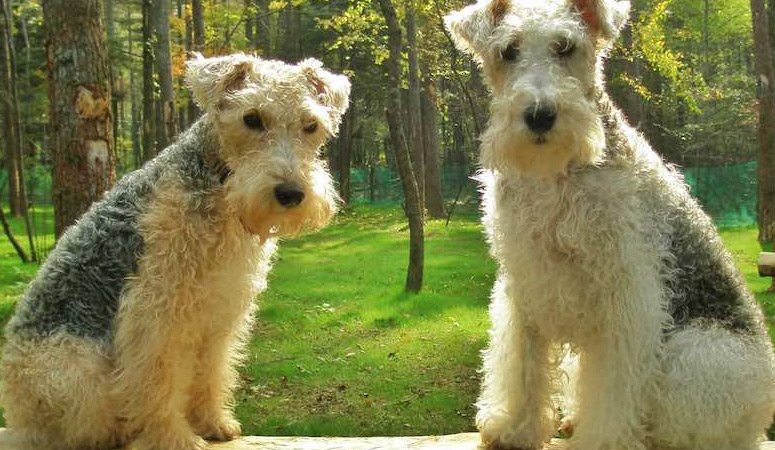Lakeland Terrier
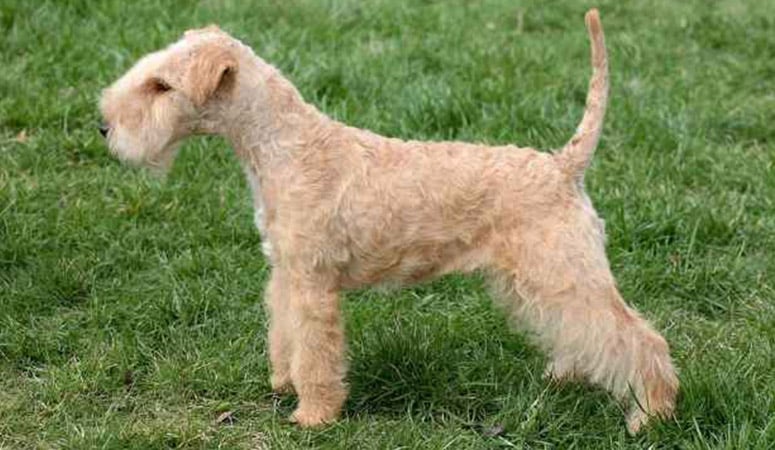
Once a dispatch dog, the Lakeland Terriers are historically raised to kill foxes and badgers. Friendly and confident as the Lakelands are, the Lakelands are not only kept by farmers nowadays, but companions of people who love them around the world.
| Other Names | Pettdale terrier |
| Color | Black, Black and Tan, Blue, Brown, Red |
| Height | Males: 14-15 inches. Females: 13-14 inches. |
| Weight | Males: 17-18 pounds. Females: 15-16 pounds. |
| Life Span | 12-15 years |
| Personality | Friendly, Confident, Bold |
| Exercise | Regular Exercise |
| Origin |
| Popularity | #148 |
| Groom Needs | Weekly Brushing/Infrequent Shedding |
| Kids Friendly | Yes with supervision |
| Dog Friendly | Yes with supervision |
| Watch Dog | |
| Family Dog | |
| Litter Size | 3-5 puppies |
Lakeland Terrier Pictures
Lakeland Terrier Video
Introduction
Farmers’ years back in the Lakeland District looked for a stealthy hunting dog, one that had athleticism and agility, health and robustness, and yet still was a companion. They found all these wonderful characteristics in the Lakeland terrier and those characteristics are still in this dog today. Their cousins are the Welsh terrier and Wire Fox terrier. In the USA, they are a rare breed, so when taking him on a walk, he invites friendly curiosity; people guess at him being a miniature Airedale, maybe an Irish terrier, or is he just a pup still? As a pup, getting him socialized is important so you end up with a well-rounded companion. If not treated fairly or spoilt and over-indulged, you will miss all the wonderful attributes. Then they can be fearful. They are affectionate and have even been affectionately called Laplanders because they can literally curl up and fit on your lap. They are gentle like nursemaids but dutiful and diligent as service dogs, particularly emotional support dogs. They have a knack of knowing how to make you feel safe – watching over you and caring for you. They make them good watchdogs but without the necessary training, will just bark at anything. Their coat is beautiful when maintained properly; they’re a non-shedding breed. Coat colors include black, blue, red, liver, and wheaten. They are OK with kids and when properly socialized will tolerate some light hugging – no abuse for them. As far as exercises go, you can’t turn a Lakie loose and expect him not to go exploring, and that’s why you will need a fenced garden.
Living with Lakeland Terrier
Lakeland Terriers are normally easy to get groomed, as their coats are hard and sheddings are infrequent. When it comes with grooming, owners might need to bath them in advance. Then groom them by using a comb, either a metal comb or a soft brush can be suitable for them. Then brush from the Lakelands’ skin surfaces to their ends of hair instead of messy grooming way, which leading to good blood circulation. A-couple-of-times-a-week grooming can be applicable to the Lakelands. Have the Lakelands’ coat hand-stripped can be a good idea to show the their outlines. In this way, owners can bring the Lakelands a sense of cool in summer, and dogs are more neat and good-looking. Owners can also ask groomer for helps as trimming is easier and more familiar for groomers. Keep the Lakelands’ coats tidy in general can contribute to a more convenient grooming afterward. And have their coat trimmed every couple of months. Their nails need to get trimmed to avoid dirt built up. Owners might need to buy pet toothpaste to brush the Lakelands’ teeth in case of any bad breath from dogs’ mouth. Grooming is not only for keeping them in good appearance but for offering them overral health.
Lakeland Terriers are very fond of playing, but longlasting exercising can be of no appealing to them. It takes owners many efforts and time to keep a hyperactive dog, as a hyperactive dog will need time and space to run off energy. The Lakelands can be hyperactive if owners raised improper. If owners don’t have that much time, training the Lakelands to be dogs who take small amount of exercise can be available. A long walk or brisk jog can be both applicable to the Lakelands. Once-a-day outdoor exercise can contribute a good mental and physical health of dogs. Though owners train the Lakelands into the dog with small amount of exercise, all-out running is still of great importance. Owners could offer them a secure enough area for them to run once in a while. Fenced open area is suitable for them. Once a month all-out running is applicable to the Lakelands.
Lakeland Terriers are not a critical about food, yet owners still need to feed them premium quality food. Firstly, Fresh and clean water is the basics of a healthy feed. Secondly, owners should concern about the suitability of dog food which should be be equivalent to their ages. Puppy, adult, and senior should eat different amount of food. Anyway, either commercially manufactured or home-made food can be both appliacable to the Lakeland. If owners find it difficult, ask your veterinarian for better advice can be a good idea. Owners need to pay attention that slightly excessive meals with exact frequency can be permissible. The key point is the frequency, as owners might find dogs bloat if there’s one more excessive meals compared with meals of other days, which might lead to health issues. At this time, owners should check out the consumption of dog’s calorie and level of weight. Owners also need to pay attention that dogs can also be overweight accidently during your training period. It can be of great importance when treats take a role as an aid in training. Excessive amount of food can lead to obesity, which cause danger to dogs’ health.
Lakeland Terriers are basically in good health, and very few breed health conditions will exist among the Lakeland Terrier. But owners need to pay attention to their overweight problems, as this may lead to bloat. Learning about what symptom is and what measure should be taken is of great importance. Owners also might need to notice that basic bathing and grooming can contribute to good health. Ears should be cleaned and checked regularly, avoiding the existence of infections and irritations. A vet-approved cottom cleanser should be appropriate. Owners also need to check their eyes if necessary, as infections on eyes can be terrible. Careful owners will do a health screen to check if there’s any bad health signs of the Lakelands.
Total Annual Cost: $2780
Cost is estimated for the first year and may vary depending on many factors, such as dog food, health care, leash, collar, licensing, possible fencing, crates, training and obedience classes, dog-walking, grooming, treats, toys, flea, tick, and heart-worm meds, microchips, etc.
Lakeland Terriers are smart. Though the Lakelands won’t be applied to working dogs, they have the potential to be raised to be a good owner helper. If owners are patient and consistent enough, it is likely for this independent breed to be trained to behave good. There are some basic techniques owners might use for reference. Firstly, Use food as rewards, frequent praise, playful learning. These are all positive reinforcement to increse the emotional connections between owner and dogs, adding more pet-owner interaction to boost training process. In this way, the Lakelands will hardly lose any interest. Secondly, owners should be serious while training, making dogs be aware that owner is the leader of the household. Thirdly, harshness will bring the Lakelands a sense of nervousness. Owners need to get the aim of training clear and definite. Training is to keep dogs’ mind and body alert and active, while harshness is not applicable to keep dogs’ mental and physical healthy.
History
The Lakeland terrier comes from the Lake District of Northern England near the Scottish Border.
He was developed to protect sheep from fox in the hills and mountains; to actually go right into the fox’s den to face the foe, fight it, and kill it underground. Records show of some dogs being stuck underground for 10-12 days – to come out. That’s how determined and tenacious he is!
The Lakeland terrier has been part of the Lake District since the 1700s.
One man, Alf Johnston, started Oregill Kennels in 1921. The first red champion he bred was called Oregill Captain and probably most Lakeland terriers go back to him.
In 1921 the Lakeland Terrier Association was formed, and it wasn’t long before the Kennel Club recognized them as a breed, giving out their first certificate in 1931.
The American Kennel Club registered this rare dog in 1934.
Helpful Information
Breed Club: United States Lakeland Terrier Club
Breed Club Link: https://lakelandterrierclubofamerica.org/
Breed Club Rescue: The US Lakeland Terrier, Inc
Breed Club Rescue Link: https://lakelandterrierclubofamerica.org/rescue/

